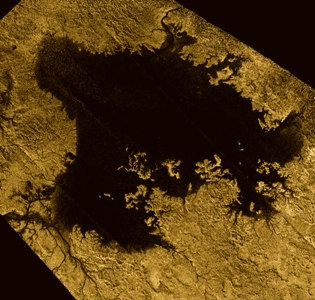
Ligiea Mare is the second largest body of liquid on Saturn's moon Titan. Photo: NASA/JPL-Caltech/ASI/Cornell
NEW DELHI (BNS): A new study has found that a large sea on Saturn's moon Titan is composed mostly of pure liquid methane, independently confirming an earlier result.
Scientists had long speculated about the possible existence of hydrocarbon lakes and seas on Titan.
Since arriving in the Saturn system in 2004, the Cassini spacecraft has revealed that more than 620,000 square miles (1.6 million square kilometres) of Titan's surface -- almost two percent of the total -- are covered in liquid.
There are three large seas, all located close to the moon's North Pole, surrounded by numerous of smaller lakes in the northern hemisphere. Just one large lake has been found in the southern hemisphere.
The exact composition of these liquid reservoirs remained elusive until 2014, when the Cassini radar instrument was first used to show that Ligeia Mare, the second largest sea on Titan and similar in size to Lake Huron and Lake Michigan combined, is methane-rich.
"Before Cassini, we expected to find that Ligeia Mare would be mostly made up of ethane, which is produced in abundance in the atmosphere when sunlight breaks methane molecules apart. Instead, this sea is predominantly made of pure methane," said Alice Le Gall, a Cassini radar team associate at the French research laboratory LATMOS, Paris, and lead author of the study.
The new study, conducted by NASA/ESA Cassini-Huygens mission, is based on data collected with Cassini's radar instrument during flybys of Titan between 2007 and 2015.
In their research, the scientists combined several radar observations of heat given off by Ligeia Mare. They also used data from a 2013 experiment that bounced radio signals off Ligeia. During the experiment, the radar instrument detected echoes from the seafloor and inferred the depth of Ligeia Mare along Cassini's track over Ligeia Mare -- the first-ever detection of the bottom of an extraterrestrial sea. The scientists were surprised to find depths in the sea as great as 525 feet (160 metres) at the deepest point along the radar track.
The study also found that the shoreline around Ligeia Mare may be porous and flooded with liquid hydrocarbons. The data span a period running from local winter to spring, and the scientists expected that -- like the seaside on Earth -- the surrounding solid terrains would warm more rapidly than the sea.
"It's a marvelous feat of exploration that we're doing extraterrestrial oceanography on an alien moon," said Steve Wall, deputy lead of the Cassini radar team at NASA's Jet Propulsion Laboratory in Pasadena, California. "Titan just won't stop surprising us."
 Previous Article
Previous Article Next Article
Next Article













The Indian Air Force, in its flight trials evaluation report submitted before the Defence Ministry l..
view articleAn insight into the Medium Multi-Role Combat Aircraft competition...
view articleSky enthusiasts can now spot the International Space Station (ISS) commanded by Indian-American astr..
view article